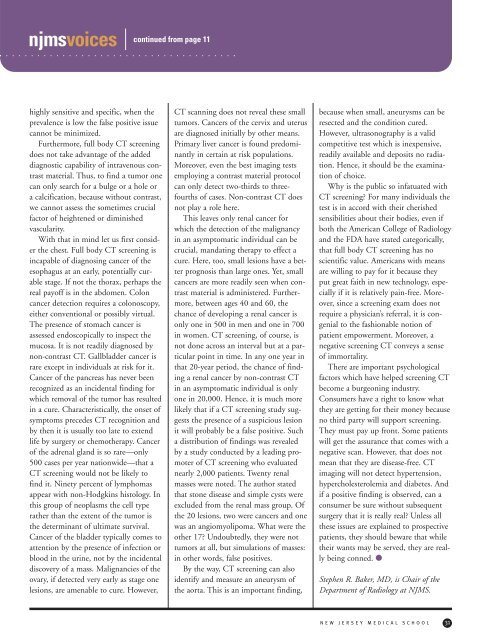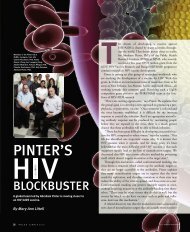changing the course of stroke - New Jersey Medical School ...
changing the course of stroke - New Jersey Medical School ...
changing the course of stroke - New Jersey Medical School ...
You also want an ePaper? Increase the reach of your titles
YUMPU automatically turns print PDFs into web optimized ePapers that Google loves.
njmsvoices<br />
highly sensitive and specific, when <strong>the</strong><br />
prevalence is low <strong>the</strong> false positive issue<br />
cannot be minimized.<br />
Fur<strong>the</strong>rmore, full body CT screening<br />
does not take advantage <strong>of</strong> <strong>the</strong> added<br />
diagnostic capability <strong>of</strong> intravenous contrast<br />
material. Thus, to find a tumor one<br />
can only search for a bulge or a hole or<br />
a calcification, because without contrast,<br />
we cannot assess <strong>the</strong> sometimes crucial<br />
factor <strong>of</strong> heightened or diminished<br />
vascularity.<br />
With that in mind let us first consider<br />
<strong>the</strong> chest. Full body CT screening is<br />
incapable <strong>of</strong> diagnosing cancer <strong>of</strong> <strong>the</strong><br />
esophagus at an early, potentially curable<br />
stage. If not <strong>the</strong> thorax, perhaps <strong>the</strong><br />
real pay<strong>of</strong>f is in <strong>the</strong> abdomen. Colon<br />
cancer detection requires a colonoscopy,<br />
ei<strong>the</strong>r conventional or possibly virtual.<br />
The presence <strong>of</strong> stomach cancer is<br />
assessed endoscopically to inspect <strong>the</strong><br />
mucosa. It is not readily diagnosed by<br />
non-contrast CT. Gallbladder cancer is<br />
rare except in individuals at risk for it.<br />
Cancer <strong>of</strong> <strong>the</strong> pancreas has never been<br />
recognized as an incidental finding for<br />
which removal <strong>of</strong> <strong>the</strong> tumor has resulted<br />
in a cure. Characteristically, <strong>the</strong> onset <strong>of</strong><br />
symptoms precedes CT recognition and<br />
by <strong>the</strong>n it is usually too late to extend<br />
life by surgery or chemo<strong>the</strong>rapy. Cancer<br />
<strong>of</strong> <strong>the</strong> adrenal gland is so rare—only<br />
500 cases per year nationwide—that a<br />
CT screening would not be likely to<br />
find it. Ninety percent <strong>of</strong> lymphomas<br />
appear with non-Hodgkins histology. In<br />
this group <strong>of</strong> neoplasms <strong>the</strong> cell type<br />
ra<strong>the</strong>r than <strong>the</strong> extent <strong>of</strong> <strong>the</strong> tumor is<br />
<strong>the</strong> determinant <strong>of</strong> ultimate survival.<br />
Cancer <strong>of</strong> <strong>the</strong> bladder typically comes to<br />
attention by <strong>the</strong> presence <strong>of</strong> infection or<br />
blood in <strong>the</strong> urine, not by <strong>the</strong> incidental<br />
discovery <strong>of</strong> a mass. Malignancies <strong>of</strong> <strong>the</strong><br />
ovary, if detected very early as stage one<br />
lesions, are amenable to cure. However,<br />
continued from page 11<br />
CT scanning does not reveal <strong>the</strong>se small<br />
tumors. Cancers <strong>of</strong> <strong>the</strong> cervix and uterus<br />
are diagnosed initially by o<strong>the</strong>r means.<br />
Primary liver cancer is found predominantly<br />
in certain at risk populations.<br />
Moreover, even <strong>the</strong> best imaging tests<br />
employing a contrast material protocol<br />
can only detect two-thirds to threefourths<br />
<strong>of</strong> cases. Non-contrast CT does<br />
not play a role here.<br />
This leaves only renal cancer for<br />
which <strong>the</strong> detection <strong>of</strong> <strong>the</strong> malignancy<br />
in an asymptomatic individual can be<br />
crucial, mandating <strong>the</strong>rapy to effect a<br />
cure. Here, too, small lesions have a better<br />
prognosis than large ones. Yet, small<br />
cancers are more readily seen when contrast<br />
material is administered. Fur<strong>the</strong>rmore,<br />
between ages 40 and 60, <strong>the</strong><br />
chance <strong>of</strong> developing a renal cancer is<br />
only one in 500 in men and one in 700<br />
in women. CT screening, <strong>of</strong> <strong>course</strong>, is<br />
not done across an interval but at a particular<br />
point in time. In any one year in<br />
that 20-year period, <strong>the</strong> chance <strong>of</strong> finding<br />
a renal cancer by non-contrast CT<br />
in an asymptomatic individual is only<br />
one in 20,000. Hence, it is much more<br />
likely that if a CT screening study suggests<br />
<strong>the</strong> presence <strong>of</strong> a suspicious lesion<br />
it will probably be a false positive. Such<br />
a distribution <strong>of</strong> findings was revealed<br />
by a study conducted by a leading promoter<br />
<strong>of</strong> CT screening who evaluated<br />
nearly 2,000 patients. Twenty renal<br />
masses were noted. The author stated<br />
that stone disease and simple cysts were<br />
excluded from <strong>the</strong> renal mass group. Of<br />
<strong>the</strong> 20 lesions, two were cancers and one<br />
was an angiomyolipoma. What were <strong>the</strong><br />
o<strong>the</strong>r 17? Undoubtedly, <strong>the</strong>y were not<br />
tumors at all, but simulations <strong>of</strong> masses:<br />
in o<strong>the</strong>r words, false positives.<br />
By <strong>the</strong> way, CT screening can also<br />
identify and measure an aneurysm <strong>of</strong><br />
<strong>the</strong> aorta. This is an important finding,<br />
because when small, aneurysms can be<br />
resected and <strong>the</strong> condition cured.<br />
However, ultrasonography is a valid<br />
competitive test which is inexpensive,<br />
readily available and deposits no radiation.<br />
Hence, it should be <strong>the</strong> examination<br />
<strong>of</strong> choice.<br />
Why is <strong>the</strong> public so infatuated with<br />
CT screening? For many individuals <strong>the</strong><br />
test is in accord with <strong>the</strong>ir cherished<br />
sensibilities about <strong>the</strong>ir bodies, even if<br />
both <strong>the</strong> American College <strong>of</strong> Radiology<br />
and <strong>the</strong> FDA have stated categorically,<br />
that full body CT screening has no<br />
scientific value. Americans with means<br />
are willing to pay for it because <strong>the</strong>y<br />
put great faith in new technology, especially<br />
if it is relatively pain-free. Moreover,<br />
since a screening exam does not<br />
require a physician’s referral, it is congenial<br />
to <strong>the</strong> fashionable notion <strong>of</strong><br />
patient empowerment. Moreover, a<br />
negative screening CT conveys a sense<br />
<strong>of</strong> immortality.<br />
There are important psychological<br />
factors which have helped screening CT<br />
become a burgeoning industry.<br />
Consumers have a right to know what<br />
<strong>the</strong>y are getting for <strong>the</strong>ir money because<br />
no third party will support screening.<br />
They must pay up front. Some patients<br />
will get <strong>the</strong> assurance that comes with a<br />
negative scan. However, that does not<br />
mean that <strong>the</strong>y are disease-free. CT<br />
imaging will not detect hypertension,<br />
hypercholesterolemia and diabetes. And<br />
if a positive finding is observed, can a<br />
consumer be sure without subsequent<br />
surgery that it is really real? Unless all<br />
<strong>the</strong>se issues are explained to prospective<br />
patients, <strong>the</strong>y should beware that while<br />
<strong>the</strong>ir wants may be served, <strong>the</strong>y are really<br />
being conned. ●<br />
Stephen R. Baker, MD, is Chair <strong>of</strong> <strong>the</strong><br />
Department <strong>of</strong> Radiology at NJMS.<br />
NEW JERSEY MEDICAL SCHOOL 31






